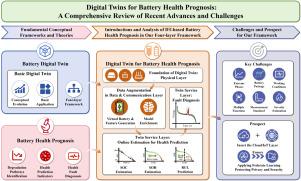Digital twins for battery health prognosis: A comprehensive review of recent advances and challenges
IF 17
1区 工程技术
Q1 ENERGY & FUELS
引用次数: 0
Abstract
This review systematically examines the integration of Digital Twin (DT) technology with lithium-ion battery health prognosis systems. As electrification accelerates across multiple domains, accurate prediction of battery health indicators – including State of Charge (SOC), State of Health (SOH), Remaining Useful Life (RUL), and fault conditions – becomes increasingly critical for ensuring safety, reliability, and optimal performance. The core contribution of this review lies in proposing a novel four-layer conceptual framework, comprising the Physical, Data & Communication, Virtual Model, and Twin Service layers, as an analytical tool for structuring the field. After establishing the theoretical foundations of DTs and battery aging, we leverage this framework to systematically survey recent advancements in data augmentation, online state estimation, and fault diagnosis. Through this structured analysis, we then identify critical implementation challenges, including performance in extreme degradation phases, battery pack inconsistencies, and operation under complex conditions. We conclude by proposing future research directions focused on enhancing model generalization and creating standardized architectures through the integration of cloud computing and IoT technologies, and applying federated learning to solve potential privacy and security problems. This review serves as a critical reference by providing a structured, application-centric understanding of DTs in battery health management.

用于电池健康预测的数字孪生:最近进展和挑战的综合回顾
本文系统地研究了数字孪生(DT)技术与锂离子电池健康预测系统的集成。随着电气化在多个领域的加速发展,准确预测电池健康指标(包括充电状态(SOC)、健康状态(SOH)、剩余使用寿命(RUL)和故障状况)对于确保安全性、可靠性和最佳性能变得越来越重要。本综述的核心贡献在于提出了一个新的四层概念框架,包括物理层、数据和通信层、虚拟模型层和双服务层,作为构建该领域的分析工具。在建立了dt和电池老化的理论基础之后,我们利用这个框架系统地调查了数据增强、在线状态估计和故障诊断方面的最新进展。通过这种结构化分析,我们确定了关键的实施挑战,包括极端退化阶段的性能、电池组不一致以及复杂条件下的运行。最后,我们提出了未来的研究方向,重点是通过云计算和物联网技术的集成来增强模型泛化和创建标准化架构,并应用联邦学习来解决潜在的隐私和安全问题。这篇综述通过对电池健康管理中的dt提供结构化的、以应用为中心的理解,作为一个重要的参考。
本文章由计算机程序翻译,如有差异,请以英文原文为准。
求助全文
约1分钟内获得全文
求助全文
来源期刊

Etransportation
Engineering-Automotive Engineering
CiteScore
19.80
自引率
12.60%
发文量
57
审稿时长
39 days
期刊介绍:
eTransportation is a scholarly journal that aims to advance knowledge in the field of electric transportation. It focuses on all modes of transportation that utilize electricity as their primary source of energy, including electric vehicles, trains, ships, and aircraft. The journal covers all stages of research, development, and testing of new technologies, systems, and devices related to electrical transportation.
The journal welcomes the use of simulation and analysis tools at the system, transport, or device level. Its primary emphasis is on the study of the electrical and electronic aspects of transportation systems. However, it also considers research on mechanical parts or subsystems of vehicles if there is a clear interaction with electrical or electronic equipment.
Please note that this journal excludes other aspects such as sociological, political, regulatory, or environmental factors from its scope.
 求助内容:
求助内容: 应助结果提醒方式:
应助结果提醒方式:


